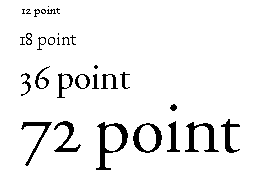 Measuring Type
Measuring Type
To understand how type works, you must know how it is measured. Basically,
typefaces can be measured in two ways: height and width.
Type Height
In earlier times when type was molded out of metal, it was sold in discrete
sizes that were measured in points. Today's digital types can be enlarged
or reduced by simply selecting, or specifying, a point size.

Originally, the term point size referred to the height of the metal body
that held the characters. This was slightly larger than the distance from
the highest to the lowest feature in the design.
A traditional point is approximately 1/72 of an inch or .01384 inch. With
the advent of desktop publishing, the point became exactly 1/72 of an inch.
12 points = 1 pica, and 6 picas = 1 inch.
This method of measuring is still used for digital type. Often, because
some faces have very long ascenders and descenders, these typefaces look
smaller than others when both are printed at the same point size. This
incongruity is illustrated below.

Type Width
In addition to height, a typeface is commonly measured by its width. The
width of a typeface is often expressed in characters per pica, that is, the
average number of characters that will fit within a pica.
Characters-per-pica information is used for copyfitting to estimate whether
text set in a specific typeface will fit into an allotted space or,
conversely, to estimate how much space a given piece of text will occupy.
This information can also be used to compare the relative widths of
different typefaces.
 Measuring Type
Measuring Type
